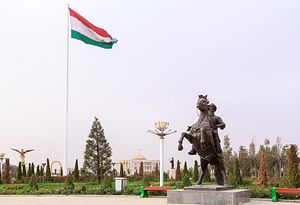Central Asia links:
No one is certain how many militants, of what kind, are along the Afghanistan-Central Asia border. Last Friday Eurasianet covered comments from a spokesman for Tajikistan’s Main Border Troops Directorate in which he was dismissive of the often-mentioned rumor that ISIS forces are massing on the border, readying a veritable invasion. A senior CIS military official was quoted by TASS this week, however, talking up the threat and saying that “some 4,500 terrorists are concentrated in near-border areas of [Afghanistan].” Joshua Kuchera pointed out on Twitter that nearly a year ago Russia was claiming that “[l]et’s say on the Tajikistan beachhead there are 4-5,000 fighters concentrated. And on the beachhead opposite Turkmenistan, 2,500 fighters.” So 4,500 is a decline–we’re still waiting for the invasion.
Because it never goes out of style, time to revisit Heathershaw and Montgomery’s seminal blog which concludes that sometimes it’s better to just admit we don’t know very much about radicalization in Central Asia–and by extension how many fighters are milling around the border.
But there are people researching, comprehensively, radicalization in the region. Edward Lemon has a journal article out (open access!) which looks at the connection between rhetoric and reality, and the effect of threat inflation on stability:
By conflating Islamisation with radicalisation, the government implements assertively secular policies which have alienated many of the country’s observant – but largely antipolitical – Muslim population.
Moving on to Kazakhstan. President Nazarbayev was in Europe last week, making deals in the U.K. and France, meanwhile in Astana the central bank head was replaced and a massive privatization plan unveiled. But not everyone is convinced that Nazarbayev’s grand plans can link up with reality. A Financial Times article this week looks at that skepticism. One analyst quoted in the article, Diana Gapak, says “[t]alking a lot about future plans without linking them to today’s realities is pretty much the way that Kazakhstan’s politicians think.”
The contradictions extend beyond economics, Sebastien Peyrouse wrote for Eurasianet this week that “Ultimately, there is a glaring religious contradiction in Kazakhstan.” Peyrouse notes that while Kazakhstan hosts the Congress of Leaders of World and Traditional Religions every three years in Astana:
There was a noteworthy discrepancy involving the gathering’s composition: there were leaders of religious groups with large global representations but an extremely small presence in Kazakhstan (including Buddhism, Taoism and Hinduism), while many movements that have a significant presence in the country were deliberately excluded from this event due to being classified as “non-traditional.”
Kazakhstan presents a tolerant facade to the world but is not, internally, tolerant. A prime example: a 54-year-old Seventh Day Adventist was convicted of “inciting religious hatred” by an Astana court and sentenced to seven years of house arrest this week. Forum 18 has an in-depth look at his case.
Finishing with a more positive story: in the Mongolian capital Ulaanbaatar, Batbold Bavuu has opened what he believes to be the country’s first specialist record store. “The most important part is the music, it’s a big part of my life, so that’s why I’m doing this,” he told the BBC. The collection includes everything from the Beetles to state-sponsored Mongolian rock bands, from Soviet-produced discs to records likely smuggled into the country in an earlier age.
































